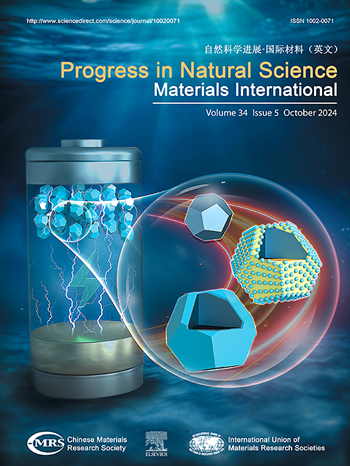不同 Zr 替代含量的自由-V Ti1-Zr Mn0.9Cr07Fe0.1 合金的综合储氢特性
IF 4.8
2区 材料科学
Q2 MATERIALS SCIENCE, MULTIDISCIPLINARY
Progress in Natural Science: Materials International
Pub Date : 2024-10-01
DOI:10.1016/j.pnsc.2024.07.011
引用次数: 0
摘要
氢已被广泛认为是一种前景广阔的新型可再生能源。开发安全高效的储氢技术是扩大氢能应用的关键。AB2 型钛锰基储氢合金具有优异的动力学和活化性能,但其综合储氢性能,尤其是低成本无 V 的钛锰基合金的储氢容量、平台压力和循环稳定性有待进一步优化。因此,我们对 Ti1-xZrxMn0.9Cr0.7Fe0.1 (x = 0.05、0.16、0.20、0.25)的储氢性能进行了系统研究。所有系列合金都含有单一的 C14 型拉维斯相结构。增加 Zr 对 Ti 的替代可提高储氢能力,降低高原压。值得注意的是,x = 0.16 合金的有效储氢能力明显高于其他合金,其平台压力也是最合适的。这种合金的氢含量达到了 1.8 wt%,并表现出卓越的循环稳定性,在 100 次循环后仍能保持 98.6% 的容量。这项研究为优化无钒低成本钛锰基合金的性能提供了理论指导。本文章由计算机程序翻译,如有差异,请以英文原文为准。
Comprehensive hydrogen storage properties of free-V Ti1-xZrxMn0.9Cr0.7Fe0.1 alloys with different Zr substitution content
Hydrogen has been widely recognized as a promising new renewable energy source. Developing safe and efficient hydrogen storage technologies is crucial for scaling up hydrogen energy applications. AB2-type Ti–Mn-based hydrogen storage alloys have excellent kinetic and activation properties, but their comprehensive hydrogen storage performance, especially the hydrogen storage capacity, platform pressure, and cycling stability of low-cost Ti–Mn-based alloys without V, needs to be further optimized. Hence, the hydrogen storage properties of the Ti1-xZrxMn0.9Cr0.7Fe0.1 (x = 0.05, 0.16, 0.20, 0.25) were systematically studied. All of the series alloys contained a single C14-type Laves phase structure. Increasing the substitution of Zr for Ti resulted in higher hydrogen storage capacities and lower plateau pressures. Notably, the effective hydrogen storage capacity of x = 0.16 alloy is significantly higher than that of the other alloys, and its platform pressure is the most suitable. This alloy achieved a hydrogen content of 1.8 wt% and demonstrated excellent cycling stability, retaining 98.6 % of its capacity after 100 cycles. This study provides a theoretical guideline for optimizing the properties of low-cost TiMn-based alloys without V.
求助全文
通过发布文献求助,成功后即可免费获取论文全文。
去求助
来源期刊
CiteScore
8.60
自引率
2.10%
发文量
2812
审稿时长
49 days
期刊介绍:
Progress in Natural Science: Materials International provides scientists and engineers throughout the world with a central vehicle for the exchange and dissemination of basic theoretical studies and applied research of advanced materials. The emphasis is placed on original research, both analytical and experimental, which is of permanent interest to engineers and scientists, covering all aspects of new materials and technologies, such as, energy and environmental materials; advanced structural materials; advanced transportation materials, functional and electronic materials; nano-scale and amorphous materials; health and biological materials; materials modeling and simulation; materials characterization; and so on. The latest research achievements and innovative papers in basic theoretical studies and applied research of material science will be carefully selected and promptly reported. Thus, the aim of this Journal is to serve the global materials science and technology community with the latest research findings.
As a service to readers, an international bibliography of recent publications in advanced materials is published bimonthly.

 求助内容:
求助内容: 应助结果提醒方式:
应助结果提醒方式:


